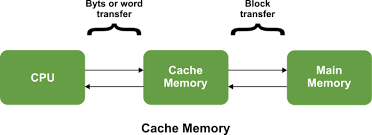MEMORY
Memory is the electronic holding place for instructions and data that your computer’s microprocessor can reach quickly. It is like the human memory that is able to store information, any element of which can be recalled or accessed when required. When your computer is in normal operation, its memory usually contains the main parts of the operating system and some or all of the application programs and related data that are being used.
The memory is divided into large number of small parts. Each part is called cell. Each location or cell has a unique address, which varies from zero to memory size minus one.
For example, if computer has 64k words, then this memory unit has 64 * 1024=65536 memory location. The address of these locations varies from 0 to 65535
Memory is primarily of three types:
• Cache Memory• Primary Memory/Main Memory
• Secondary Memory
CACHE MEMORY
Cache memory is a very high speed semiconductor memory, which can speed up CPU. It acts as a buffer between the CPU and main memory. It is used to hold those parts of data and program which are most frequently used by CPU. The parts of data and programs are transferred from disk to cache memory by operating system, from where CPU can access them.

Advantage
• Cache memory is faster than main memory.• It consumes less access time as compared to main memory.
• It stores the program that can be executed within a short period of time.
• It stores data for temporary use.
Disadvantage
• Cache memory has limited capacity.• It is very expensive.